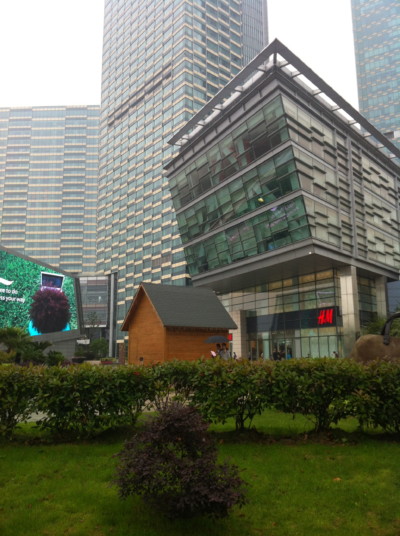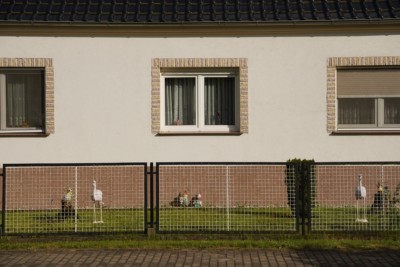“Lifestyled – Health and Places”, a 2016 publication of research at Harvard University presents part of the results of a research initiative developed through the Health and Places Initiative (HAPI) at Harvard University. With a multi-disciplinary approach, the research examines urban development models with the focus on the relationships between health and places. Following the first section “Public Health and the Design of the Built Environment” with essays and interviews providing an overview of the relationship between health and places, the second section has its focus situated in China and exemplarily examines the “Chinese Superblock”, charting some of the contemporary challenges around the realm of residential neighborhoods. The third section presents more background research as well as some results from a design studio for a specific case study in Songjiang New Town. Health and Places: within History
Starting with the seemingly common-sense of a connection between “health” and “places”, the first chapter “Public Health and the Design of the Built Environment” provides historical accounts of how design, the profession of urban planning, landscape planning and modern architecture are largely transformed and shaped by the concern for and reforms in public health.
From Hippocrates’ search for a causal relationship between health and the environment in Airs, Waters and Places in the 5th century BC to Vitruvius’ description of configurations of towns based on wind directions to ensure the well-being of citizens, there is a long history of design profession’s engagement with health concerns.
But nothing can compare with the preoccupations of public health during the period of industrialization and urbanization in the late 19th and the beginning of the 20th century in Britain, due to acute and contagious diseases.
Under the influence of positivism and utilitarianism, public health concerns and actors who came to shape the built environment converged on an institutional level, bringing about the Public Health Act in England of 1848, as well as the use of scientific techniques such as mapping and statistics. Being tools of research and analysis as well as seemingly objective evidence at the same time, these rational and scientific methods were operative and instrumental technology, and at the same time a polemical device for advancing the agenda of the hygiene movement (p. 18). They acted as a moral promotion to carry out studies of human collectives as statistical categories or citizens as mere “population” (p. 21), and pushed the design disciplines towards the rational and the scientific.
The subsequent application of scientific planning principles under the influence of the hygiene movement and social and health reforms largely shaped European cities, from Haussmann’s restructuring of Paris to the construction of London’s embankment along the Thames, and finally Le Corbusier’s modern visions (p. 21). The adoption of the operative tools led to the reorientation of the design profession towards its role as applied science. In the field of urban planning, the engineer Ildefons Cerdà made use of scientific analysis to prove the inadequacy of the old city of Barcelona for people’s health and made his extension plan with a mathematical basis of the ratios between the buildings and the public space. Frederick Law Olmsted, who set an early example of landscape architecture as a profession, served as a public health official before his engagement in landscape planning notably including the Central Park in New York, with the idea to cultivate landscape in the city as a space for the public (p. 25). The modern design ethos as opposed to the stylistic and representative canons of traditional architectural language has its roots already with Jean Louis Durand of the École Polytechnique in France, but the triumph of the elevation of function as the determinant of design and the dissolution of stylistic rules were, besides stylistic and technological impulses, under the influence of reform movements including the hygiene movement (p. 26). In fact Le Corbusier’s five points of architecture stress foremost a healthy lifestyle.
Health and Places: with Reflection
Recognizing the obvious impact that places have on public health, it would be oversimplified to adopt a deterministic view. Catastrophes are often mobilized as vehicles for historical transformations and the moral high ground of health as a social target served as propaganda for radical renewal. The attitude of environmental determinism and the “pairing between physical and moral health” led to the judgement that the ambiguity of the environment of the urban poor was pathological, as asserted in Charles Booth’s descriptive maps of London poverty in 1892. The assumed model of disorder was fought against and “innovative” designs emerged, aggressively turning the wind towards the coherent and the orderly, followed by slum clearances and relocation campaigns driven by philanthropy. And middle class lifestyles were promoted as the universal standard (p. 29). Historically, equating the health of environment and human health proves to be a vision of naiveté. Seen from a revisionist view towards the modern period, the demolition of the infamous American social housing project Pruitt-Igoe in 1972 is often considered as a failure to provide good design, the public policy which advocated a “white flight” to the newly built suburbs and the subsequent disinvestment in city centers and segregation are factors beyond the design realm (p. 30). It forces the design profession and the good-willed reformists to reflect and recognize that the impact of the built environment alone as a medium for health reform is limited.
With the rapid urbanization of developing countries in vast areas of the world, a renewed demand toward a convergence of design and health topics emerges. The contemporary times certainly face a different challenge compared to the age of industrialization. While acute and contagious diseases related to hygiene were the main battlefield back then, the threats today are the so-called “non-communicative” or chronic, lifestyle diseases, responsible for 60% of all deaths in the world (p. 1). Also a rapidly aging population and human being’s mismanagement of the environment emerge as new problematic fields of our epoch. Since 1946, WHO renewed the definition of health not just as the absence of diseases but included social and mental wellbeing.
While the reformists during the modern period optimistically believed in the decisive role that the environment has for health, with what could be called “contextual influences”, a more prevalent view in the decades afterwards was to focus on individual, that is, “compositional influences”, with the emphasis on education, institution and medical care. In recent years, the inadequacy of the focus on individual influences and the insufficiency of locating some problems such as obesity with individual explanations are perceived and there is a resurgent interest in “contextual influences” to examine the built environment again. For lifestyle diseases, WHO identifies: “city living can impose certain limitations in which people live, and restricts their opportunities to be healthy” (p. 4).
Health and Places: Under a New Convergence
Learning from historic lessons, the authors appeal for a more nuanced attitude towards the health issue as a renewed convergence between health and place emerges. In the process of urbanization of unprecedented speed, a balance between reflection and projective momentum is called for (p. 31). With the new interest in contextual influences, the authors integrated two interviews as the second chapter of the book and ask what the new convergence implies. In the words of environmental and developmental psychologist Dr. Gary Evans, physical environment can be “opportunities or constrains for healthy choices”, “make it easier or harder to do certain things” (p. 61). Or as social epidemiology expert Dr. Ichiro Kawachi’s says, it can “encourage or discourage social interactions” (p. 56), and designers need to “understand the public health consequences of what they do” (p. 50).
Besides individual modifiable activities such as exercise and eating habits, when it comes to obesity, walkability and food environment are also important factors. These are what Dr. Ichiro Kawachi calls “nudges” or what Richard Thale calls “choice architecture” – the default options in the environment (p. 46-47). Dr. Gary Evans pointed out the relevance of spatial terms, such as the need for privacy in order to “regulate social interaction”, the importance to control the density of users within one room (p. 64), and the underlying harm of intuitive adaptation to unpleasant and loud environments (p. 68).
Recognizing the “reciprocal relationships between people and their environments” (p. 5) and thus taking both compositional and contextual factors into consideration, the question today is how our built environment can help to foster healthy “lifestyles” or at least not become a barrier which hinders people to “make healthy choices”, such as taking physical exercises, getting a healthier diet, having leisure and social opportunities, and inclusive access to public places.
Moreover, instead of solely relying on the formation of ideal master plans, frameworks and guidelines, the confluence of influences of various levels should be recognized (p. 31-32).
China: Diagnosis
The elimination of epidemics of communicative diseases was also a target during the Mao era. Today, changes in diet and nutrition and the lack of physical exercise, the shift from active commuting to motorized transport result in non-communicative diseases. China is suffering from double malnutrition: cases of under-nutrition and increasing over-nutrition at the same time (p. 215). Chronic diseases account for 80% of all deaths for China; when it comes to cancer, China suffers from 27% of the world’s total deaths (p. 2). In addition, China is facing an aging population due to the high average life expectancy and partly as a result of the one-child policy enacted in 1979. In 2013, filial piety, which is part of the feudal Confucian ethos and a family responsibility, was again emphasized and made a law (p. 7). It shifts the responsibility to care for elderly people onto the younger one-child generations, because the nation increasingly faces the problem of an aging population without having an institutionalized solution (p. 7).
While the impact of the built environment on health is clearly to be recognized, it should be seen that design can not replace political, institutional and social conditions. Take carbon emissions as an example, the individual lifestyles of the Chinese population are comparatively less problematic than the industrial practices. When it comes to individual lifestyles, the public policy and planning practices which favor sprawl has led to the widespread use of automobiles as a main source of local pollution (p. 8).
China’s Superblock
The third and fourth chapter of the book are dedicated foremost to a specific typology, namely the “superblock”, which is the most prevalent housing form in China. Based on the definition by Alan Colquhoun for superblock as “a large tract of real estate which is financed and organized as a single entity” (p. 92), the widespread superblocks in China reflect a radical application of modern ideals of mono-functional buildings organized with a traffic planning to separate vehicles and pedestrians, with supposed efficiency (p. 98). Measuring 400-300m in length on average, the over-determinant modernist design rarely allows any adaption. The increasing use of private cars adds problems of traffic congestion in spite of wide surrounding streets of 30-50m. The ubiquitous north-south orientation of the blocks often turn the streets into wind tunnels (p. 99).
The checkerboard configuration of a city has a long history in China. From the canonical form described in Zhou Li to the famous city layout of the Tang Dynasty capital Chang’An (today’s Xi’an), China has a long history of organizing residential units into walled residential wards. The superblock, however, is a modern legacy of a new scale with its origin from the “Siedlung” typology during the Red Vienna era, which found a similar formal expression in Le Corbusier’s Ville Radieuse with towers in a park within a grid of large blocks. During the 1930s, the “urbanists” school in the Soviet Union proposed the concept of “microdistricts” based on four-sided blocks around a quadrangle. These microdistricts were realized only in the late 1950s, supported by the technique of large panel construction which was widely used during the after-war period as a fast and inexpensive method. At the same time, a housing crisis of similar scale existed also in China; after an ideological discussion, the big socialist neighborhoods with encircling arterial streets and residential blocks with roadside shops were preferred over the “capitalistic” Anglo-American neighborhoods (p. 96-97). Learning from the Soviet Union, the target was to “transform the cities of consumption to cities of production” (p. 216). Work and life of the inhabitants of cites were organized in working units “danwei” under the hukou registration system. Taking the form of a walled unit with secure entry gates, working units and the residential typology “dayuan” were located on the city periphery where there was readily available land. The replication of the Soviet model, the low density and its tendency towards a sprawling urbanization were transplanted and applied extensively all over the country (p. 211-213).
The commercial housing development after 1978 inherited many spatial features of the dayuan housing in the danwei; with the name xiaoqu, new gated communities with superblocks continue the mass-produced development types with repetition of building units – with an unprecedented speed and scale. Today, auctions for land-use rights are held by local governments and developers buy plots for real estate developments of xiaoqu (p. 228-230).
While criticizing the unreflected planning practices of mega plots, master plans, zoning or over-determinant detailed control plans which gave birth to the numerous superblocks in the first place, the authors also see the large and widespread superblocks as chances to integrate sustainable approaches, enhance environmental performances as well as in-situ integration of public access networks, towards more human scale, diverse and resilient cities (p. 102).
The research presented in the fifth chapter goes beyond the nominative formal aspects of the superblocks and examines concepts such as family, governance and environment in China, which are closely related to the form of living. For example, the authors trace the idea of family in the modern history of China from the “New Culture Movement” in the 1910s-1920s to the establishment of administrative villages (Xingzheng Cun). While feudal clan structures and family ties were constantly broken down and individuals were supposed to align themselves to the nation or the party, the family has been again and again repositioned within the bureaucratic structure. (p. 206-210). There is also an introduction to how governance structures changed as the result of the divergence of work place and living place after the commodification of housing in 1978. The Community Committee “Shequ” was introduced to incorporate the former Residence Committees “jumin weiyuan hui” and acts as the main body of organizing daily communal affairs including healthcare services (p. 213). And when it comes to environmental issues, although the government had emphasized that it would not follow the “pollute first, treat later” practice of industrialized countries, reality shows a different picture due to the discrepancy between the guidelines issued by the central government and the lack of execution on local levels (p. 216). Results of research and design studio works are also introduced in the fifth chapter, which explores how the nominative approach of the Chinese superblocks can be reconsidered and what possible strategies exist, with a specific site in Songjiang New Town in Shanghai.
The article above is a review of the publication of: David May and Leire Asensio Villoria (eds.): Lifestyled – Health and Places, Berlin: Jovis Verlag, 2016.
Health and Places Initiative (HAPI)
ZHANG Zhen
Sie ist wissenschaftliche Mitarbeiterin am Lehr- und Forschungsgebiet Architekturtheorie an der RWTH Aachen und ist Gastautorin für CITYMAKERS. Als Kuratorin der Ausstellung “Planetary Urbanism – the Transformative Power of Cities” im Deutschen Pavillon hat sie an der UN-Habitat III Konferenz in Quito, Ecuador, teilgenommen. Für ihrer Masterarbeit „Isle of Islay – Nature Observatory – Remembrance of a Forgotten Treaty between Man and Nature“ hat sie die besondere Auszeichnung zum BDA-SARP-Award erhalten und wurde für den Euregional Preis (EAP) nominiert. 2011-2013 war sie als Architektin bei von Gerkan, Marg und Partner Shanghai tätig. Als Architektin und internationale Projektkoordinatorin hat sie das Deutsch-Chinesische Haus auf der Weltausstellung 2010 in Shanghai mitrealisiert.
Contact
zhen.zhang@rwth-aachen.de





